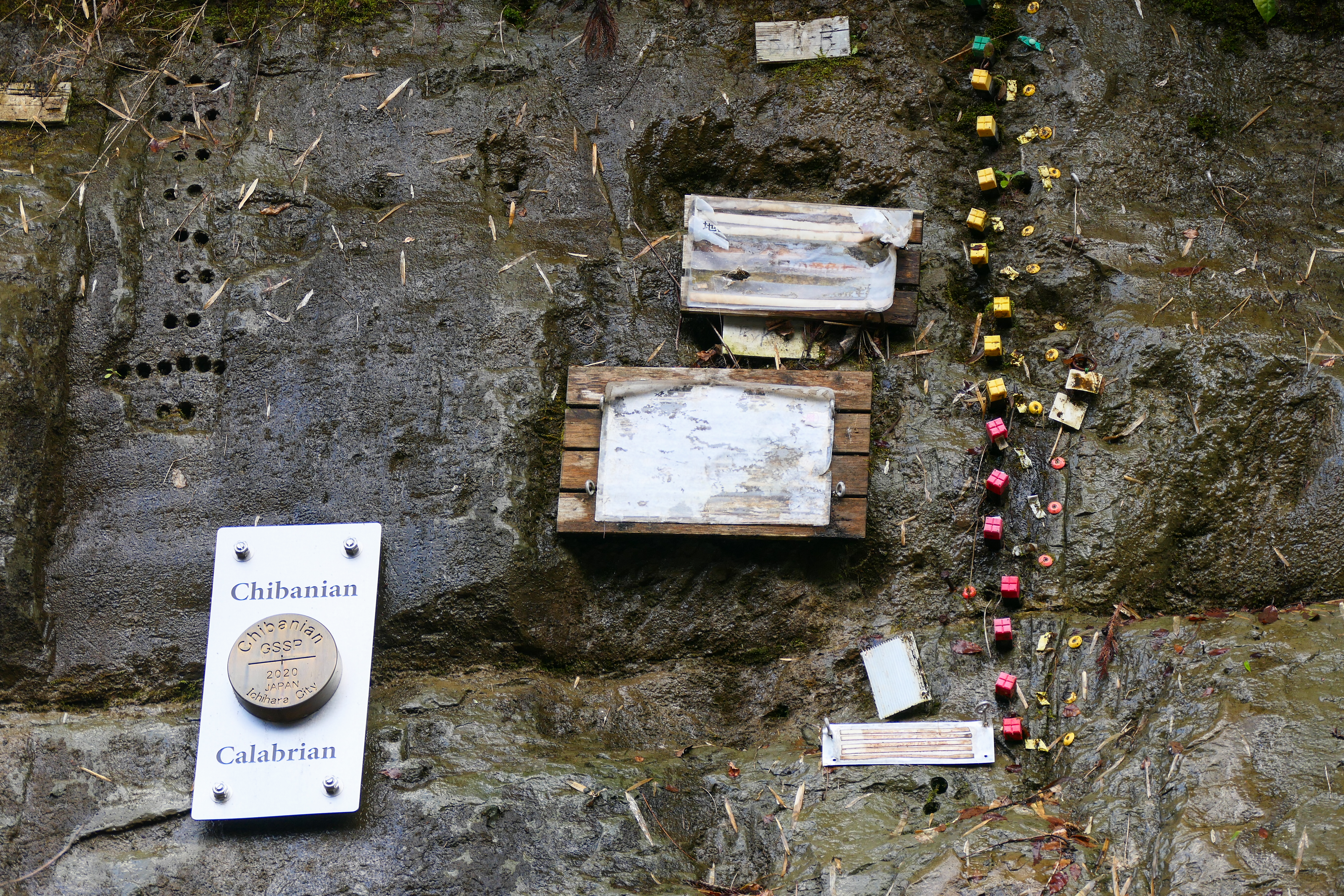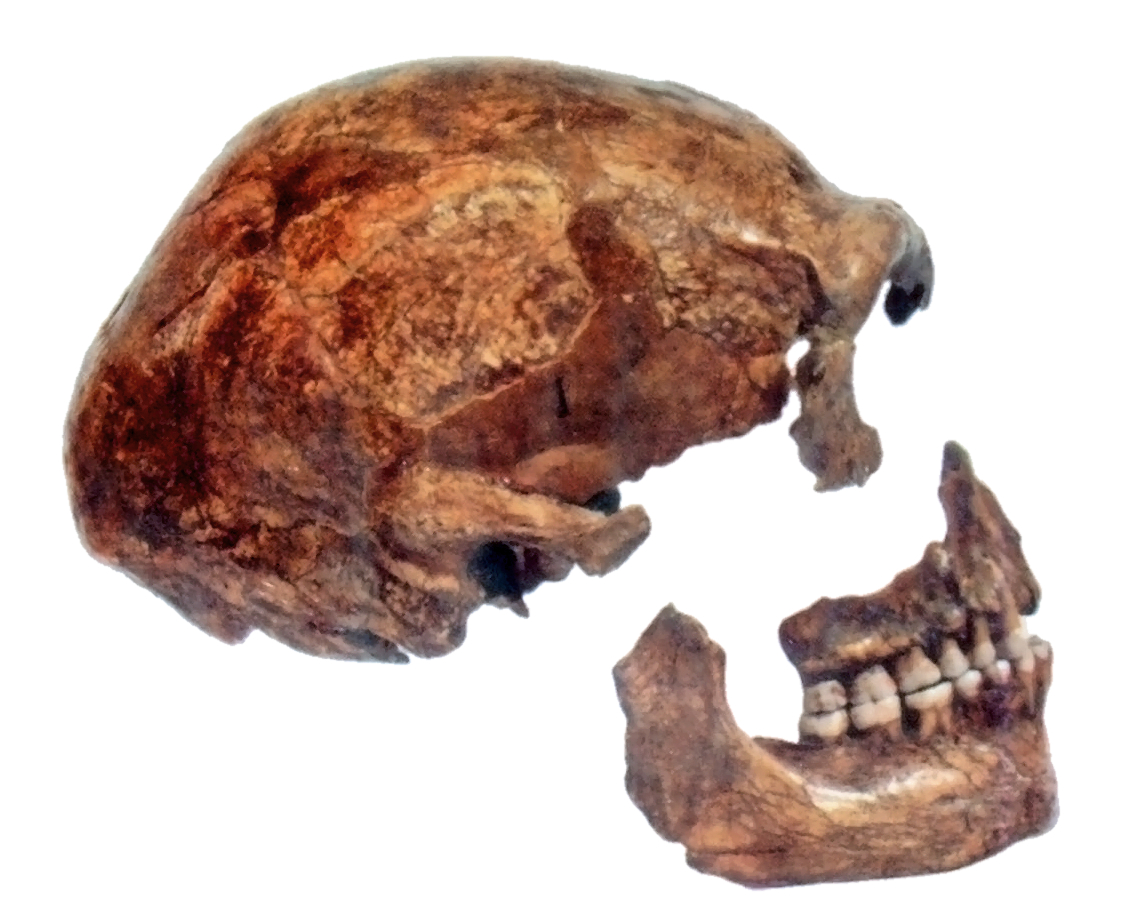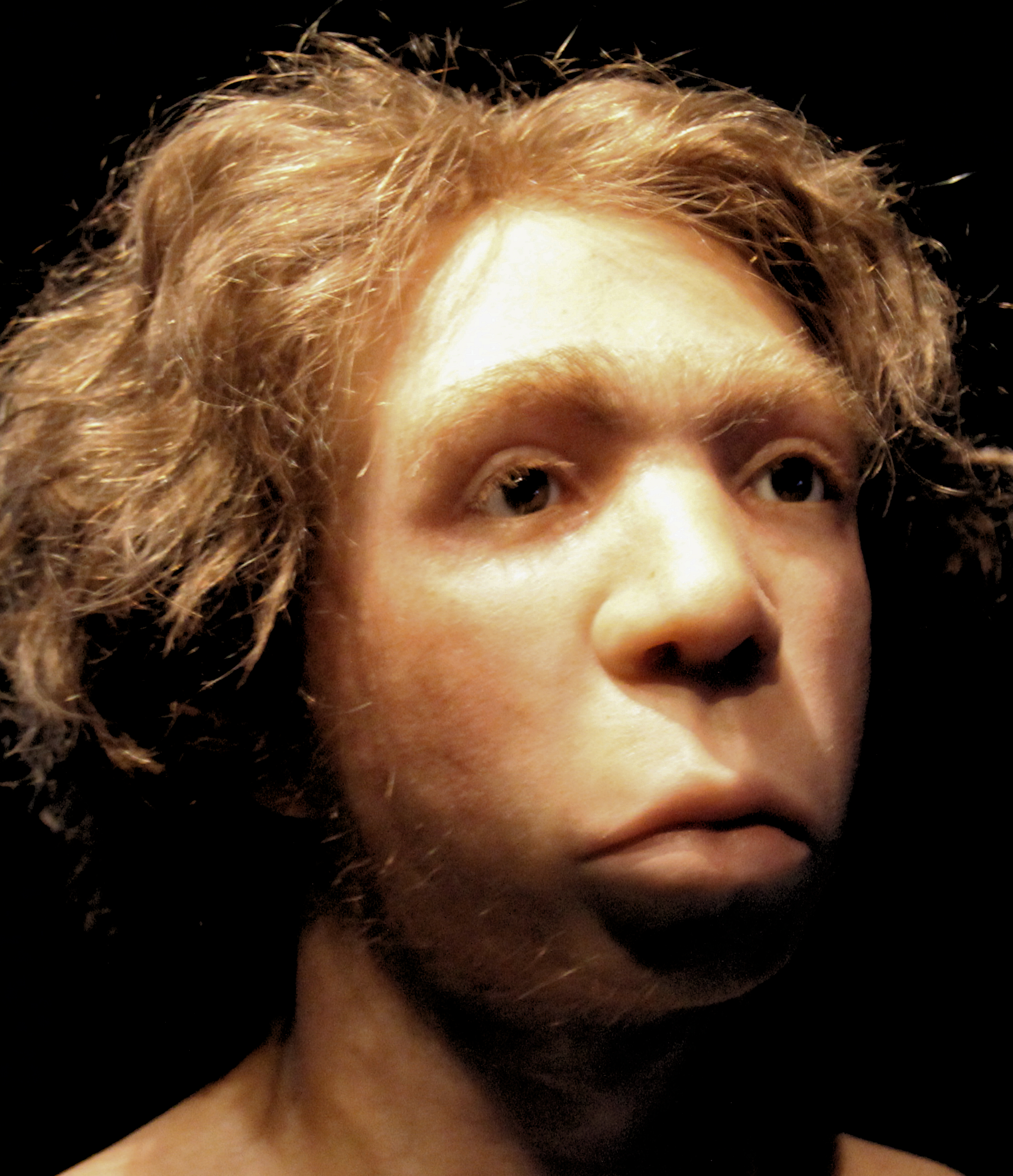|
Neanderthal Fossils
Neanderthals ( ; ''Homo neanderthalensis'' or sometimes ''H. sapiens neanderthalensis'') are an extinct group of archaic humans who inhabited Europe and Western and Central Asia during the Middle to Late Pleistocene. Neanderthal extinction occurred roughly 40,000 years ago with the immigration of modern humans (Cro-Magnons), but Neanderthals in Gibraltar may have persisted for thousands of years longer. The first recognised Neanderthal fossil, Neanderthal 1, was discovered in 1856 in the Neander Valley, Germany. At first, Neanderthal 1 was considered to be one of the lower races in accord with historical race concepts. As more fossils were discovered through the early 20th century, Neanderthals became characterised most especially by Marcellin Boule as a unique species of underdeveloped human. By the mid-20th century, human evolution was described as progressing from an apelike ancestor, through a "Neanderthal phase", ending in modern humans. This gave way to the "Out of ... [...More Info...] [...Related Items...] OR: [Wikipedia] [Google] [Baidu] |
Middle Pleistocene
The Chibanian, more widely known as the Middle Pleistocene (its previous informal name), is an Age (geology), age in the international geologic timescale or a Stage (stratigraphy), stage in chronostratigraphy, being a division of the Pleistocene Epoch within the ongoing Quaternary Period. The Chibanian name was officially ratified in January 2020. It is currently estimated to span the time between 0.7741 annum, Ma (774,100 years ago) and 0.129 Ma (129,000 years ago), also expressed as 774.1–129 ka. It includes the transition in palaeoanthropology from the Lower Paleolithic, Lower to the Middle Paleolithic over 300 ka. The Chibanian is preceded by the Calabrian (stage), Calabrian and succeeded by the Late Pleistocene. The beginning of the Chibanian is the Brunhes–Matuyama reversal, when the Earth's magnetic field last underwent reversal. Its end roughly coincides with the termination of the Penultimate Glacial Period and the onset of the Last Interglacial period (correspondin ... [...More Info...] [...Related Items...] OR: [Wikipedia] [Google] [Baidu] |
Neanderthal 1
Feldhofer 1 or Neanderthal 1 is the scientific name of the 40,000-year-old Type (biology), type specimen fossil of the species Neanderthal, ''Homo neanderthalensis''. The fossil was discovered in August 1856 in the Kleine Feldhofer Grotte cave in the Neander Valley (''Neandertal''), located east of Düsseldorf, Germany. In 1864, the fossil's description was first published in a scientific journal, where it was officially named.William King (geologist), William King: ''The Reputed Fossil Man of the Neanderthal''. In: ''Quarterly Journal of Science''. Vol. 1, 1864, pp. 88–97Full text (PDF; 356 kB)/ref> Neanderthal 1 was not the first Neanderthal fossil ever discovered. Other Neanderthal fossils had been found earlier but were not recognized as belonging to a distinct species. Discovery Limestone has been mined in the Neander Valley since the early 16th century. By the mid-19th century, mining operations had expanded to an industrial scale. In August 1856, two Italian wor ... [...More Info...] [...Related Items...] OR: [Wikipedia] [Google] [Baidu] |
Glacial Period
A glacial period (alternatively glacial or glaciation) is an interval of time (thousands of years) within an ice age that is marked by colder temperatures and glacier advances. Interglacials, on the other hand, are periods of warmer climate between glacial periods. The Last Glacial Period ended about 15,000 years ago. The Holocene is the current interglacial. A time with no glaciers on Earth is considered a Greenhouse and icehouse Earth, greenhouse climate state. Quaternary Period Within the Quaternary, which started about 2.6 million years before present, there have been a number of glacials and interglacials. At least eight glacial cycles have occurred in the last 740,000 years alone. Changes in atmospheric and associated radiative forcing were among the primary drivers of globally cold glacial and warm interglacial climates, with changes in ocean physical circulation, biological productivity and seawater acid-base chemistry likely causing most of the recorded changes Penul ... [...More Info...] [...Related Items...] OR: [Wikipedia] [Google] [Baidu] |
Genetic Drift
Genetic drift, also known as random genetic drift, allelic drift or the Wright effect, is the change in the Allele frequency, frequency of an existing gene variant (allele) in a population due to random chance. Genetic drift may cause gene variants to disappear completely and thereby reduce genetic variation. It can also cause initially rare alleles to become much more frequent and even fixed. When few copies of an allele exist, the effect of genetic drift is more notable, and when many copies exist, the effect is less notable (due to the law of large numbers). In the middle of the 20th century, vigorous debates occurred over the relative importance of natural selection versus neutral processes, including genetic drift. Ronald Fisher, who explained natural selection using Mendelian inheritance, Mendelian genetics, held the view that genetic drift plays at most a minor role in evolution, and this remained the dominant view for several decades. In 1968, population geneticist Mot ... [...More Info...] [...Related Items...] OR: [Wikipedia] [Google] [Baidu] |
Natural Selection
Natural selection is the differential survival and reproduction of individuals due to differences in phenotype. It is a key mechanism of evolution, the change in the Heredity, heritable traits characteristic of a population over generations. Charles Darwin popularised the term "natural selection", contrasting it with selective breeding, artificial selection, which is intentional, whereas natural selection is not. Genetic diversity, Variation of traits, both Genotype, genotypic and phenotypic, exists within all populations of organisms. However, some traits are more likely to facilitate survival and reproductive success. Thus, these traits are passed the next generation. These traits can also become more Allele frequency, common within a population if the environment that favours these traits remains fixed. If new traits become more favoured due to changes in a specific Ecological niche, niche, microevolution occurs. If new traits become more favoured due to changes in the ... [...More Info...] [...Related Items...] OR: [Wikipedia] [Google] [Baidu] |
Occipital Bun
An occipital bun, also called an occipital spur, occipital knob, chignon hook or inion hook, is a prominent bulge or projection of the occipital bone at the back of the human skull, skull. It is important in scientific descriptions of classic Neanderthal crania. It is found among Archaic humans, archaic ''Homo'' species (including Neanderthals), as well as Late Pleistocene, Upper Pleistocene ''Human, Homo sapiens'' and present-day human populations. Occipital buns in Neanderthals The occipital bun is a protuberance of the occipital bone. Its size and shape has been compared to that of a dinner roll. It is a quintessential trait of Neanderthals, though it is a trend in archaic ''Homo'' species. The true purpose of the occipital bun has not yet been defined. However, some studies have found possible evolutionary purposes. In a study published in ''Proceedings of the Royal Society B'', the occipital bun has been attributed to the enlargement of the visual cortex; this is hypot ... [...More Info...] [...Related Items...] OR: [Wikipedia] [Google] [Baidu] |
Neanderthal Anatomy
Neanderthal anatomy is characterised by a long, flat skull and a stocky body plan. When first discovered, Neanderthals were thought to be anatomically comparable to Aboriginal Australians, in accord with historical race concepts. As more fossils were discovered in the early 20th century, French palaeontologist Marcellin Boule defined them as a slouching, apelike species; a popular image until the middle of the century. Neanderthal features gradually accreted in European populations over the Chibanian, Middle Pleistocene, driven by natural selection in a cold climate, as well as genetic drift when populations crashed during glacial periods. This culminated in the "classical Neanderthal" anatomy by the Last Interglacial. The Neanderthal skull is distinctive by namely a rounded supraorbital torus (brow ridge), large orbit (anatomy), orbits (eye sockets) and nose, and an occipital bun at the back of the skull. The jaws and teeth are strong, which may have been a response to habitual ... [...More Info...] [...Related Items...] OR: [Wikipedia] [Google] [Baidu] |
Interbreeding Between Archaic And Modern Humans
Interbreeding between archaic and modern humans occurred during the Middle Paleolithic and early Upper Paleolithic. The interbreeding happened in several independent events that included Neanderthals and Denisovans, as well as several unidentified hominins. In Europe, Asia and North Africa, interbreeding between archaic humans and Early modern human, modern humans took place several times. The introgression events into modern humans are estimated to have happened about 47,000–65,000 years ago with Neanderthals and about 44,000–54,000 years ago with Denisovans. Neanderthal-derived DNA has been found in the genomes of most contemporary populations, varying noticeably by region. It accounts for 1–4% of modern genomes for people outside Sub-Saharan Africa, although estimates vary, and either none or up to 0.3% for those in Sub-Saharan Africa. Cushitic-speaking peoples, Cushitic and Semitic languages, Semitic speaking populations from the Horn of Africa (such as Ethiopians), wh ... [...More Info...] [...Related Items...] OR: [Wikipedia] [Google] [Baidu] |
Neanderthal Genetics
Neanderthal genetics testing became possible in the 1990s with advances in ancient DNA analysis. In 2008, the Neanderthal genome project published the full sequence Neanderthal mitochondrial DNA (mtDNA), and in 2010 the full Neanderthal genome. Genetic data is useful in testing hypotheses about Neanderthal evolution and their divergence from early modern humans, as well as understanding Neanderthal demography, and interbreeding between archaic and modern humans. Modern humans and Neanderthals had multiple different interbreeding episodes, but Neanderthal-derived genes in the present-day human genome descends from an episode 250,000 years ago probably in Eurasia, and 47,000 to 65,000 years ago in the Near East. While 20% of the Neanderthal genome survives today, most people only carry about a few percentage points of Neanderthal DNA, and most Neanderthal-derived genes is non-coding DNA. Neanderthals maintained a low genetic diversity and suffered from inbreeding depression; consequ ... [...More Info...] [...Related Items...] OR: [Wikipedia] [Google] [Baidu] |
Recent African Origin Of Modern Humans
The recent African origin of modern humans or the "Out of Africa" theory (OOA) is the most widely accepted paleoanthropology, paleo-anthropological model of the geographic origin and Early human migrations, early migration of early modern human, anatomically modern humans (''Human, Homo sapiens''). It follows the early expansions of hominins out of Africa, accomplished by ''Homo erectus'' and then ''Neanderthal, Homo neanderthalensis''. The model proposes a "monogenism, single origin" of ''Human, Homo sapiens'' in the taxonomic sense, precluding parallel evolution in other regions of traits considered anatomically modern humans, anatomically modern, but not precluding multiple Archaic human admixture with modern humans, admixture between ''H. sapiens'' and archaic humans in Europe and Asia. ''H. sapiens'' most likely developed in the Horn of Africa between 300,000 and 200,000 years ago, although an alternative hypothesis argues that diverse morphological features of ''H. sap ... [...More Info...] [...Related Items...] OR: [Wikipedia] [Google] [Baidu] |
Human Evolution
''Homo sapiens'' is a distinct species of the hominid family of primates, which also includes all the great apes. Over their evolutionary history, humans gradually developed traits such as Human skeletal changes due to bipedalism, bipedalism, dexterity, and complex language, as well as interbreeding with other hominins (a tribe of the Homininae, African hominid subfamily), indicating that human evolution was not linear but weblike. The study of the origins of humans involves Interdisciplinary, several scientific disciplines, including Biological anthropology, physical and evolutionary anthropology, paleontology, and genetics; the field is also known by the terms anthropogeny, anthropogenesis, and anthropogony—with the latter two sometimes used to refer to the related subject of hominization. Primate evolution, Primates diverged from other mammals about (Myr, mya), in the Late Cretaceous period, with their earliest fossils appearing over 55 mya, during the Paleocene. Prima ... [...More Info...] [...Related Items...] OR: [Wikipedia] [Google] [Baidu] |
Marcellin Boule
Pierre-Marcellin Boule (1 January 1861 – 4 July 1942), better known as merely Marcellin Boule, was a French palaeontologist, geologist, and anthropologist. Early life and education Pierre-Marcellin Boule was born in Montsalvy, France. Career Boule was a professor at the Muséum National d’Histoire Naturelle, Paris (1902–1936) and "for many years director of the Institut de Paléontologie Humaine, Paris." He was an editor (1893–1940) of the journal ''L’Anthropologie'' and was the founder of two other scientific journals. Boule studied and published in 1911 the first analysis of a complete Neanderthal specimen. The fossil discovered in La Chapelle-aux-Saints was an old man, and Boule characterized it as brutish, bent-kneed and not a fully erect biped. In an illustration Boule commissioned, the Neanderthal was characterized as a hairy gorilla-like figure with opposable toes, according to a skeleton which was already distorted with arthritis Arthritis is a ge ... [...More Info...] [...Related Items...] OR: [Wikipedia] [Google] [Baidu] |








